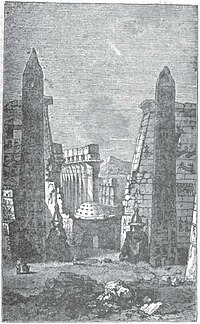Luxor Obelisks
This article needs additional citations for verification. (October 2014) |
The Luxor Obelisks (French: Obélisque de Louxor) are a pair of Ancient Egyptian obelisks carved to stand either side of the portal of the Luxor Temple in the reign of Ramesses II. The left-hand obelisk remains in its location in Egypt, but the right-hand stone, 23 metres (75 ft) high, is now at the centre of the Place de la Concorde in Paris, France. The Luxor Obelisk in Paris was classified officially as a Monument historique in 1936; beneath it is the Métro station, Concorde. The obelisks are of syenite and inscribed with hieroglyphs in honour of the Pharaoh Ramesses II.
Luxor Obelisk in the Place de la Concorde, Paris[]

The 3,000-year-old obelisks were originally both situated outside of Luxor Temple. The Parisian example first arrived in Paris on 21 December 1833, having been shipped from Luxor via Alexandria and Cherbourg,[1] and three years later, on 25 October 1836, was moved to the centre of Place de la Concorde by King Louis-Phillipe. It had been given to France by Muhammad Ali Pasha, ruler of Ottoman Egypt in exchange for a French mechanical clock. After the Obelisk was taken, the mechanical clock provided in exchange was discovered to be faulty, having probably been damaged during transport. The clock still exists in a clock-tower at Cairo Citadel and is still not working. In 2021 the Supreme Council of Antiquities announced that "Egypt is seeking to repair the citadel clock, one of the oldest of its type in the world, so that it will work again."[2]
The granite obelisk rises 23 metres (75 ft) high, including the base, and weighs over 250 metric tons (280 short tons). Given the technical limitations of the day, transporting it was no easy feat. The French government ordered a purpose-built seagoing freighter built by the Toulon naval yard. This 49 metres long, flat bottomed, three masted ship named the Louqsor was sailed up the Nile to Luxor where 300 workmen dug a canal to allow the ship to come close to the obelisk. The French seamen then lowered the obelisk with an array of blocks and tackles, yardarms, and capstans. In August 1832, the French paddle ship Sphinx sailed to Alexandria, and rendezvoused there with the barge Louqsor, which was loaded with the obelisk. Sphinx then towed Louqsor back to France. The ships departed on 1 April 1833 and reached Toulon on 10 May. The ships arrived at Cherbourg on 12 August 1833. The re-erection of the obelisk on the Place de la Concorde during a ceremony carefully planned by King Louis-Philippe I was not an easy engineering feat either. This successful French transport operation predates the eventful transport of Cleopatra's Needle by the British by more than thirty years.
The present-day pedestal was originally intended for an equestrian statue of King Louis XVI by Cortot, which was destroyed during the July Revolution in 1830. On the pedestal are drawn diagrams explaining the complex machinery that was used for the transportation, just as the pedestal of the Obelisk of Theodosius has relief carvings showing that ancient Egyptian obelisk's re-erection in Constantinople. The Paris obelisk is flanked on both sides by fountains constructed at the time of its erection. The original Egyptian pedestal included the statues of sixteen fully sexed baboons. Deemed too obscene for public exhibition; it is displayed in the Egyptian section of the Musée du Louvre.[3]
Since the original pyramidion was missing (believed stolen in the 6th century BC), the government of France added a gold-leafed pyramid cap to the top of the obelisk in 1998.

Modern events[]
- On the morning of 1 December 1993, the anti-AIDS Charity covered the Parisian obelisk with a giant pink condom to mark World AIDS Day.[4][5]
- In 1998 and 2000 Alain "Spiderman" Robert, the French urban climber, scaled the Parisian obelisk without the use of any ropes or other climbing equipment or safety devices.
- In 2015, the French artist and engineer Milène Guermont installed her monumental work PHARES[6] on the Place de la Concorde in Paris. It is the first time in history that a work has been created near the Obelisk, the oldest monument in Paris. This 30-meter-high sculpture is made of a golden aluminum mesh covered with car headlights. PHARES plays with light both day and night thanks to its cardiac sensor, which allows the public to cause its illumination live.
See also[]
References[]
| Wikimedia Commons has media related to Luxor Obelisk. |
- ^ "The Luxor Obelisk Monument In Paris France". eutouring.com.
- ^ Nevine El-Aref. "175-year-old Cairo Citadel clock to be repaired". ahramonline, 6 May 2021.
- ^ "Four baboons adoring the rising sun | Louvre Museum | Paris". www.louvre.fr. Retrieved 8 July 2016.
- ^ "Civismemoria.fr - Interviews en tout genre !". Archived from the original on 8 March 2009.
- ^ http://www.qrd.org/qrd/aids/cdc/daily.summaries/1993/12.01.93
- ^ "Phares (2015)".
- Follert, Michael. (2014). Enjoyment Petrification: The Luxor obelisk in a melancholic century.
- Levin, William C. (2006). Cultural Commentary: Le Vin in Paris. Bridgewater Review, 25(1), 30-32. Available at:
- Place de la Concorde: Obélisque de Luxor
- Ancient Egyptian obelisks
- Buildings and structures in the 8th arrondissement of Paris
- Obelisks in France
- Seti I
- Ramesses II
- Monuments and memorials in Paris
- Relocated ancient Egyptian monuments



